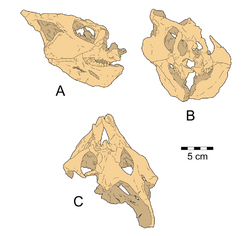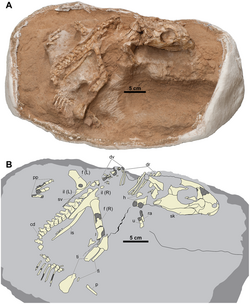Biology:Yamaceratops
| Yamaceratops | |
|---|---|

| |
| Holotype skull | |
| Scientific classification | |
| Domain: | Eukaryota |
| Kingdom: | Animalia |
| Phylum: | Chordata |
| Clade: | Dinosauria |
| Clade: | †Ornithischia |
| Suborder: | †Ceratopsia |
| Infraorder: | †Neoceratopsia |
| Genus: | †Yamaceratops Makovicky & Norell, 2006 |
| Type species | |
| †Yamaceratops dorngobiensis Makovicky & Norell, 2006
| |
Yamaceratops is a genus of primitive ceratopsian that lived in Asia during the Late Cretaceous period in what is now the Javkhlant Formation. Initially, the rocks where it was found in were thought to be from the Early Cretaceous, but the age was reevaluated in 2009.[1] It was a relatively small dinosaur, reaching 50 cm (1.6 ft) in length and 2 kg (4.4 lb) in body mass.[2]
The type species, Yamaceratops dorngobiensis, was described by P. J. Makovicky and M. A. Norell in September, 2006. The authors consider the animal to have had an intermediate phylogenetic position between Liaoceratops and Archaeoceratops within Neoceratopia. Examination of the frill of Yamaceratops has convinced the authors that the frill was not used for display, and that the fossils "[hint] at a more complex evolutionary history for ceratopsian frills". Furthermore, Yamaceratops has been dated to either Aptian-early Albian, to even as early as mid-Barremian. This likely predated Archaeoceratops and Helioceratops, but not Liaoceratops. While there are many similarities between all four specimens, placing any into a specific family can be extremely difficult, and hotly contested between research teams.[3]
The genus name refers to Yama, a Tibetan Buddhist deity; the species name to the Eastern Gobi. The holotype IGM 100/1315 consists of a partial skull; other material has been found in 2002 and 2003 and has been ascribed to the genus.[3]
A fossilized embryo found within an ornithischian eggshell from sediments where Yamaceratops is common, was in 2008 referred to this genus.[4] However, in 2015 it was reidentified as a bird embryo.[5]
In 2020 Minyoung Son and colleagues reported a juvenile specimen of Yamaceratops found in 2014 at the Khugenetjavkhlant ("Khugenslavkhant") locality.[6] This probably three years old specimen, MPC-D 100/553, was described in detail in 2022.[7]
See also
References
- ↑ Eberth, David A.; Kobayashi, Yoshitsugu; Lee, Yuong-Nam; Mateus, Octávio; Therrien, François; Zelenitsky, Darla K.; Norell, Mark A. (2009). "Assignment of Yamaceratops dorngobiensis and associated redbeds at Shine Us Khudag (eastern Gobi, Dorngobi Province, Mongolia) to the restricted Javkhlant Formation (Upper Cretaceous)". Journal of Vertebrate Paleontology 29 (1): 295–302. doi:10.1080/02724634.2009.10010384. https://www.researchgate.net/publication/259105787.
- ↑ Paul, Gregory S. (2016). The Princeton Field Guide to Dinosaurs. Princeton University Press. pp. 279. ISBN 978-1-78684-190-2. OCLC 985402380. http://worldcat.org/oclc/985402380.
- ↑ Jump up to: 3.0 3.1 Makovicky, Peter J.; Norell, Mark A. (2006). "Yamaceratops dorngobiensis, a new primitive ceratopsian (Dinosauria: Ornithischia) from the Cretaceous of Mongolia". American Museum Novitates (3530): 1–42. doi:10.1206/0003-0082(2006)3530[1:YDANPC2.0.CO;2]. http://digitallibrary.amnh.org/dspace/bitstream/2246/5808/1/N3530.pdf.
- ↑ Balanoff, A.M.; Norell, M.A.; Grellet-Tinner, G.; Lewin, M.R. (2008). "Digital preparation of a probable neoceratopsian preserved within an egg, with comments on microstructural anatomy of ornithischian eggshells". Naturwissenschaften 95 (6): 493–500. doi:10.1007/s00114-008-0347-2. PMID 18347769. Bibcode: 2008NW.....95..493B.
- ↑ Varricchio D.J., Balanoff A.M., Norell M.A., 2015, "Reidentification of Avian Embryonic Remains from the Cretaceous of Mongolia", PLoS ONE 10(6): e0128458
- ↑ Son, M.; Lee, Y.-N.; Zorit, B.; Park, J.-Y.; Lee, S.; Kim, S.-H.; Lee, K.-Y. (2020). "A juvenile Yamaceratops dorngobiensis (Ornithischia, Ceratopsia) from the Upper Cretaceous Javkhlant Formation of Mongolia". Journal of Vertebrate Paleontology Program and Abstracts: 311. https://vertpaleo.org/wp-content/uploads/2021/03/SVP_2020_Program-Abstracts-Volume-FINAL-for-Publishing-1.27.2021.pdf.
- ↑ Son, M.; Lee, Y.-M.; Zorigt, B.; Kobayashi, Y.; Park, J.-Y.; Lee, S.; Kim, S.-H.; Lee, K. Y. (2022). "A new juvenile Yamaceratops (Dinosauria, Ceratopsia) from the Javkhlant Formation (Upper Cretaceous) of Mongolia". PeerJ 10: e13176. doi:10.7717/peerj.13176. PMID 35402094.
External links
- Dinosaur Mailing List announcement of the description (contains full abstract of the paper)
- Description and Image (in German)
Wikidata ☰ Q132517 entry
 |



